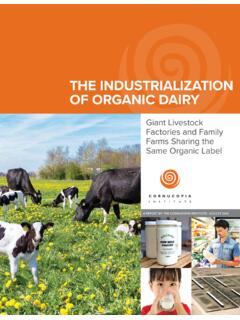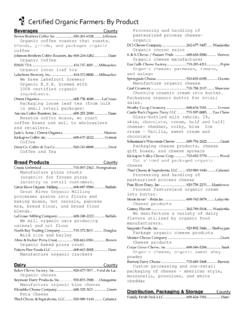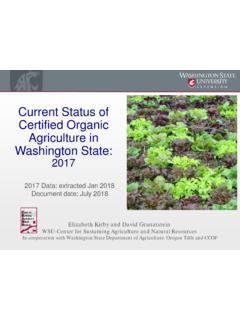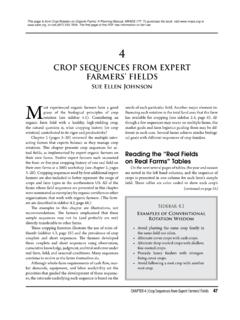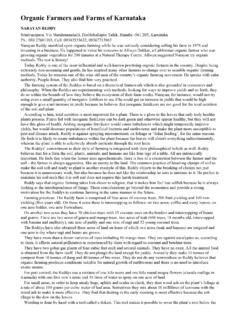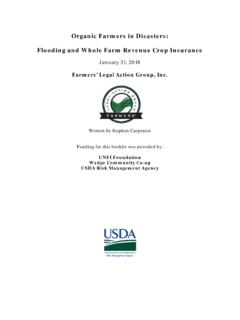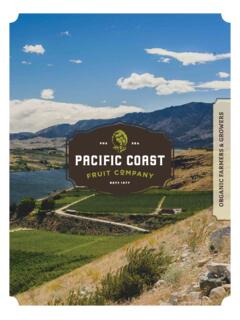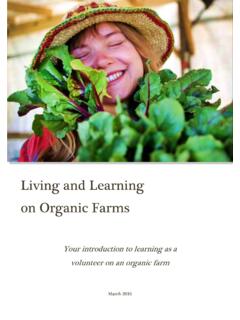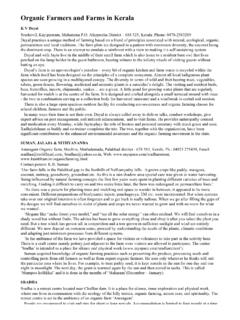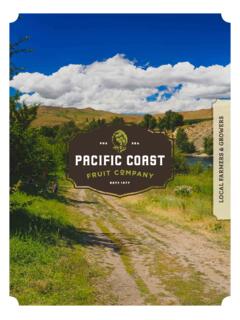Transcription of THE INDUSTRIALIZATION OF ORGANIC DAIRY - cornucopia.org
1 Giant Livestock Factories and Family Farms Sharing the Same ORGANIC LabelTHE INDUSTRIALIZATION OF ORGANIC DAIRYA REPORT BY THE CORNUCOPIA INSTITUTE | AUGUST 2018iv THE INDUSTRIALIZATION OF ORGANIC DAiRYThe Cornucopia Institute wishes to thank the foundations that support our research and the thousands of family farmers and ORGANIC advocates who fund this work with their generous donations. The following staff members helped research, write, support, and edit this report:Marie Burcham, JD, Principal Author Mark Kastel, Senior Policy Analyst Rachel Zegerius, EditorThe Cornucopia Institute is chartered as a tax-exempt public charity focusing on research and education. Cornucopia aims to empower ORGANIC producers, consumers, and wholesale buyers to make discerning marketplace decisions, protecting the credibility of the ORGANIC food and farming movement and the value it delivers to Cornucopia Institute Box 126 Cornucopia, WI 54827 608-425-2000 voice 866-861-2214 fax design and layout: Draft Horse Studio | Scorecard design: 9 Seeds | All photos, except where noted: Adobe StockCopyright 2018, The Cornucopia InstituteGiANT LivESTOCK FACTORiES AND FAMiLY FARMS SHARiNG THE SAME ORGANIC LABEL 1 EXECUTIVE SUMMARYSINCE THE CORNUCOPIA INSTITUTE S ORIGINAL DAIRY REPORT in 2006, the INDUSTRIALIZATION of ORGANIC DAIRY has steadily progressed.
2 Although USDA agricultural census data is somewhat dated, many industry observers believe more ORGANIC milk now comes from livestock factories. Most of these giant ORGANIC dair-ies employ suspect practices that are common in the conventional agriculture industry. * Most family farm DAIRY operations range from 50-100 cows. Although an exception, some dairies, with expert management and help from extended family members, can milk hundreds of cows successfully. Though a multi-generational model is a common occurrence in small ORGANIC producers, not every family farm represents a biological family s farm ownership; it could be represented by an individual or on- farm years of aggressive growth, the annual increase in ORGANIC DAIRY consumption has flattened, while industri-al-scale dairies continue to increase production, flooding the market with surplus milk.
3 This has resulted in cata-strophic cuts in farmgate pricing and production quotas. The current marketplace lot of ORGANIC milk has placed the livelihoods of ORGANIC DAIRY producers from around the country in jeopardy. These industrial- ORGANIC dairies and the businesses mar-keting their milk skirt ORGANIC regulations, harm the en-vironment, compromise the nutritional content of ORGANIC DAIRY products, and sacrifice the health and well-being of livestock. They also undermine the ORGANIC market, mak-ing it difficult for ethical family-scale* ORGANIC farmers to get a fair price for their milk and maintain their illustrate the grotesquely disproportionate scale of some of these ORGANIC dairies operating in the semi-desert conditions of Texas, Idaho, Colorado, and Cali-fornia, Texas alone produces times more ORGANIC milk than Wisconsin.
4 Wisconsin, commonly known as America s Dairyland, has 75 times more ORGANIC pro-ducers (453 versus the six in Texas, according to the most recent USDA data).Regulators, under pressure from large agribusiness inter-ests, are failing to maintain the integrity of ORGANIC DAIRY . They could do so by enforcing existing regulations that would shut down or constrain these mammoth operations. With this report, Cornucopia urges conscientious consum-ers to differentiate between authentic ORGANIC production and greenwashing, to support family-scale ORGANIC dair-ies, and force the ORGANIC DAIRY industry to clean up its act. Cornucopia s accompanying mobile-friendly ORGANIC DAIRY Brand Scorecard is designed to empower consum-ers and wholesale buyers to make these important market-place decisions.
5 The ORGANIC seal is the only federally regulated label that mandates the process by which a product is grown and processed. The United States Department of Agriculture (USDA) controls the rules govern-ing ORGANIC DAIRY production. Independent certifying agencies accredited by the USDA grant use of the label, giving certified ORGANIC farms and proces-sors access to a growing niche mar-ket. The ORGANIC seal repre-sents an alternative to the environmental and human health problems created by the conventional industrial food system. These problems include the use of toxic agrichemicals and genetically modified organisms (GMOs), overuse of antibiotics and other drugs in livestock, and long-lasting consequences for human and environmental consumers believe ORGANIC food is healthier and safer, and scientific evidence continues to accumulate to support this ,4,5 Additionally, consumers who have concerns about the humane treatment of livestock have turned to organics as an THE INDUSTRIALIZATION OF ORGANIC DAiRYMarkedly different approaches to milk production have emerged in the ORGANIC DAIRY sector, despite uniform federal standards.
6 The label is threatened by powerful economic interests that want a share of the approximated $47 billion ORGANIC Loose interpretations and lax enforcement of the ORGANIC standards have led to a market where the ORGANIC seal is displayed on DAIRY products representing a wide range of production prac-tices. Pasturing ruminants is a prominent element in the federal ORGANIC regu-lations. Many ORGANIC DAIRY farmers embrace the use of grazing as a major part of their cows diets, supplement-ing with ORGANIC grain in moderation. A few producers go above and beyond by maximizing grazing, sometimes feed-ing no grain or calorie supplements at all. On the other side of the spectrum, or-ganic concentrated animal feeding op-erations (CAFOs)* favor practices that are almost identical to conventional industrial-scale DAIRY production.
7 These mega-dairies often feed large amounts of grain and raise cattle in confinement. Despite these dramatic disparities, all ORGANIC DAIRY producers and their certifiers claim to be following the same federal standards. The reality is that administration of the regula-tions varies widely based on differing interpretations, working definitions, and applications of the standards. The USDA, intended by Congress to be the arbiters of industry disputes, has generally delegated the interpretation of the standards to independent certify-ing agencies hired by farm and agribusiness operators. Many of the largest certifiers (California Certified Or-ganic farmers , Quality Assurance International, Oregon Tilth, and others) have adopted the most liberal interpre-tations of the ORGANIC standards.
8 Some of these lax inter-pretations have been challenged as order for consumers to trust and benefit from the or-ganic label on DAIRY products, the standards for ORGANIC DAIRY production must have a straightforward and uni-form interpretation. The ORGANIC DAIRY industry is still considered one of the big success stories in contemporary Consid-* The Environmental Protection Agency defines CAFOs as an agricultural enterprise with more than 1,000 animal units (an animal unit equates to 700 DAIRY cows) confined on site for more than 45 days during the the market s tendencies in the past, sales of organ-ic fluid milk more than tripled between 2007 and 2015, while sales of conventional (non- ORGANIC ) fluid milk In fact, there was a gradual but steady increase in demand for all ORGANIC DAIRY products between 2005 and ,9,10 2017 bought change to these trends, however.
9 At the end of 2017, new data was released showing ORGANIC milk sales had declined 2% in part because of a consumer shift toward plant-based According to the USDA, retail prices for ORGANIC whole milk in December were down in a majority of the cities they surveyed, while rising or remaining unchanged in the remainder of sur-veyed cities (compared to January 2017).12 The ORGANIC seal has given small and medium-size farms the opportunity to make a living wage in an age when the INDUSTRIALIZATION of agriculture has driven many of their conventional neighbors out of dairying 1. Estimated total US sales of ORGANIC Fluid milk Products, 2008-2017. Note that a surplus gives buyers more leverage on pay price. For more charts, see LivESTOCK FACTORiES AND FAMiLY FARMS SHARiNG THE SAME ORGANIC LABEL 3 Since the creation of federal ORGANIC standards in the early 1990s, farmers that make the sometimes difficult transition to ORGANIC have been rewarded by being able to sell their products for a premium price.
10 This premium covers the additional expenses required to be ORGANIC and provides these farmers with a stable income (although in some recent years profitability has been worse on some ORGANIC farms than conventional).The ORGANIC seal has given small and medium-size farms the opportunity to make a living wage in an age when the INDUSTRIALIZATION of agriculture has driven many of their conventional neighbors out of dairying DAIRY farmers still enjoy greater pricing con-sistency than other commodity producers; however, a current surplus of ORGANIC milk, primarily driven by industrial sources, is now putting dramatic downward pressure on farm -gate prices. This downward pressure is also, in some cases, placing farmers on quotas that can create profound economic stress.
